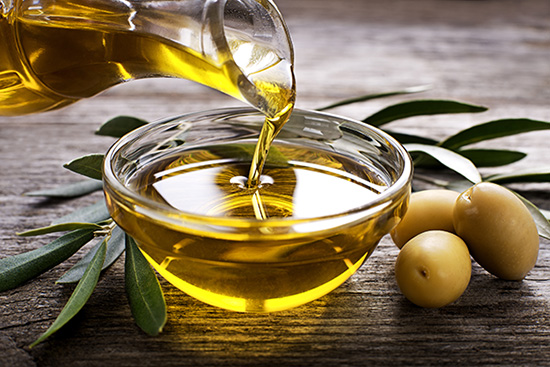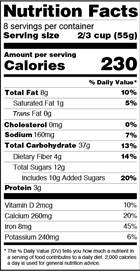
It is necessary for our bodies to consume dietary fats. Fat functions in many ways within our bodies. It plays an important role in cell function, in protecting our organs, in nutrient absorption and is used for hormone production. Fat also helps to keep us satisfied, or satiated, for longer after consuming a meal or snack.
Why is everyone so afraid of fat? Fat contains 9 calories per gram. In comparison, both protein and carbohydrates contain 4 calories per gram. Fat is more than double the amount of calories for a portion half the size. Therefore, fat should be used sparingly. Even if you are consuming a healthy source of fat, you may be consuming too many calories per serving for weight maintenance or weight loss. There are different types of fats, some are better for our bodies than others.
TYPES OF FAT
Saturated Fat: These types of fats are generally solid at room temperature. You can think of these fats as your “artery clogging” fats. They can safely be consumed in small amounts. The Dietary Guidelines for Americans recommends limiting saturated fat intake to no more than 10% of your total calories. If you are taking in a 2,000 calorie diet your saturated fats should be no more than 22 grams per day. If you are post op and are closer to 1,000 calories a day, you should consume no more than 11 grams per day.
The following are all sources of saturated fat:
- Animal fat (Beef, pork, lab, poultry)
- Lard and cream
- Butter
- Cheese
- Ice cream
- Coconut oil
- Palm oil
Trans Fat: Trans fats can occur naturally in small amounts in dairy or meat products. Trans fats are also created artificially by adding hydrogen to liquid fats to make them solid. They do this to produce a spreadable product. Trans fats are often used for frying because they typically can be reused which helps restaurants to cut costs. Your intake of trans fats should be as close to 0g per day as possible.
The following are common foods that contain trans fats:
- Packaged doughs such as biscuits and rolls
- Margarine
- Shortening
- Non-dairy coffee creamer
- Microwave popcorn
- Prepackaged baked goods
- Fried foods
- Some frozen pizzas
Unsaturated Fat: I like to think of saturated fats as our “artery lubricating” fats. Though fat should always be used sparingly, the fats we want to have more frequently would be our unsaturated fats. The Dietary Guidelines for Americans recommends limiting total fat intake to 27 grams per day based on a 2,000 calorie diet, and 15 grams per day based on a 1,000 calorie diet.
The following are all sources of unsaturated fat:
- Olive oil
- Peanut butter and peanut oil
- Vegetable oils: sunflower, safflower, corn, or canola
- Fatty fish: salmon, tuna, sardines and mackerel
- Avocados and avocado oil
- Nuts and seeds: Almonds, peanuts, sunflower seeds and cashews
LOOK AT THE LABEL
You can figure out how much fat is in a food item by looking at the food label. The food label will show you total fat, saturated fat, and trans fat. To determine the amount of unsaturated fat, you would take the amount of total fat, in this case 8 grams, and you would subtract the amount of saturated and trans fat. This label is for a food that contains 7 grams of unsaturated fat.
CHOLESTEROL
Cholesterol is a wax-like substance found naturally in our bodies. Cholesterol is used in hormone production, to produce vitamin D and aids in digestion. Chances are you know someone who has high cholesterol. Someone may have high cholesterol for reasons that are not related to dietary habits, however, the food we eat can raise, or lower, our cholesterol levels. If we have too much cholesterol in our bodies, it can build up in our arteries. The narrowing of our arteries makes it difficult for blood to flow easily. Too much cholesterol, or plaque, in our arteries can cause a blood clot, stroke, heart disease or a heart attack.
The following factors put you at higher risk of developing high cholesterol: family history and genetics, increasing age, certain medications, obesity, a diet high in saturated or trans fats, inactivity and smoking.
Soluble fiber can lower bad cholesterol (LDL & VLDL) levels. Soluble fiber turns into a gel-like substance and binds to cholesterol, which decreases the amount that we absorb through our food. Good sources of soluble fiber include oats, peas, beans, apples, citrus fruits, carrots, barley and psyllium.
Foods with added plant sterols and stanols work similarly to bind with cholesterol to decrease the absorption. Fruits, vegetables, beans, nuts, seeds, and some vegetable oils naturally contain plant sterols and stanols.
Saturated and trans fats raise bad cholesterol (LDL & VLDL) levels. Foods to avoid would be fatty meats, butter, full fat-dairy, many commercially processed baked goods, margarine and hydrogenated vegetable oil.
Written by: Gigi Ravenhall, RDN
References:
https://www.heart.org/en/healthy-living/healthy-eating/eat-smart/fats/dietary-fats
https://www.dietaryguidelines.gov/
https://www.eatright.org/health/wellness/heart-and-cardiovascular-health/what-is-cholesterol
Power of Protein
Pump Up Your Protein Intake
Why is protein such an important nutrient?
- Maintains and replaces tissues in your body
- Organs, muscles and many hormones are made up of protein
- Needed to make hemoglobin, which carries oxygen to your body
- Manufactures antibodies to fight infection and improve your immune system
- An energy source
What is high quality protein?
High quality protein is found in animal products (lean beef, pork, fish and poultry), low fat dairy, and eggs. High quality protein helps you to feel fuller longer and stay energized. Eating protein rich foods may help prevent snacking between meals. Research indicates that high-quality protein may help build muscle strength and prevent muscle loss.
What is whey protein?
Whey protein is a high quality protein powder from cow’s milk. It is often referred to as the “Gold Standard” of protein as it is the most nutritious protein available. Whey protein is a very easy to digest protein. It enters the body quickly to provide the important essential amino acids needed to nourish muscles and other body tissues. Consuming protein, especially whey protein after exercise is a great way to get the most benefits from exercise. Consuming a serving of whey protein along with a carbohydrates helps to promote the movement of protein in your bloodstream into your muscles as well. After your exercise routine try having a protein shake mixed with 100% whey powder, 8 ounces of skim milk and 1/4 cup berries.
Why is consuming protein so important after bariatric surgery?
The goal is to get 60-80 grams of high quality protein daily. Not consuming enough protein could lead to hair loss, muscle loss and poor skin tone. Always eat protein rich foods first at the meal. Each ounce of meat has 7 grams of protein. Whey protein isolate supplements are also an excellent source of protein and post surgery they are easier to digest and be more. An excellent source of protein and post surgery they are easier to digest and be more readily absorbed by the body
To increase protein intake, try these tips
- Mix in one scoop of vanilla whey protein powder into your oatmeal. This will add approximately 20 additional grams of protein to start off your day
- Blend up a smoothie using one scoop of protein powder, 1/4 cup of berries, and one cup each of milk and ice
- Add in one-half scoop of vanilla or chocolate protein powder into your morning coffee. Mix well for a creamy morning protein coffee (let hot liquids sit for 5 minutes before adding protein powder)
- 1 cup low-fat Greek Yogurt with nuts or mix in 2 tsp. ground flax seed and unflavored 100% whey protein powder
- Add legumes such as chickpeas to your diet. Adding legumes to your salad helps increase the protein content
- Pair a mixed green salad with a fruity whey protein drink. Several companies, such as Isopure, make excellent and great tasting alternatives to the typical milky whey protein beverages
- Stir in a scoop of plain powder into yogurt for a delicious cool dessert
- Throw a whey protein bar and a piece of fruit in to your bag. This protein and carbohydrate combination will hold you through to your next meal and give you an added boost of 12 to 20 grams of protein, depending on the bar
- Add plain protein powder to warm soup. Note: Do not add whey protein prior to cooking, as this may denature the proteins
- Stir plain powder into your favorite pasta sauce, like Alfredo or spaghetti sauce, after cooking
It’s important to know that one single scoop of protein powder generally contains about 20 grams of protein. One scoop per day may be enough to meet your requirements.
Nutritional Tips
Get started on the road to better portion control!
Pay attention when you eat. It’s easy to overdo it when you’re unconscious of how much you’re taking in. Don’t mindlessly eat in front of the television, computer, or in the car. Before you know it, you may have eaten a whole bag of chips or cookies.
Focus on eating your protein first, produce second, and save your starchy foods for last.
There is room for all kinds of foods in a healthy diet, it is just important to remain mindful and intuitive during the eating process.
Eat less and savor more. There’s no reason to make some foods completely off limits. For example, if you crave chocolate, your new eating plan may not last long if you forbid yourself from eating it. A forbidden food may turn into one you binge on. Try just a small taste every day if it keeps you on track.
Don’t worry about wasting food. Contrary to what you may have heard from your mother while growing up, it’s okay to leave some food on your plate. Some experts even say that leaving a small amount of food on your plate is symbolic of having control over your food.
Eat three meals a day. This will keep your blood sugar and mood more stable. That will prevent “lows” that might lead you to turn to food and bingeing due to excessive hunger from skipping meals.
Develop a taste for lower-calorie, lower-fat foods. Eat as much as you want of most vegetables, as long as they aren’t fried, creamed or smothered in butter. It may take a few weeks for your taste buds to become accustomed to less fat in your diet, but after a few weeks higher fat foods will taste too greasy.
Don’t be afraid of eating meat. Lean meat contains lots of healthy nutrients. Just take small helpings, trim the fat, and don’t have it at every meal.
Set Yourself Up For Success! Goal Setting
Consider this conversation from the fairytale Alice in Wonderland:
Alice: “Which way should I go?”
Cat: “That depends on where you are going.”
Alice: “I don’t know where I am going.”
Cat: “Then it doesn’t matter which way you go.”
– Lewis Carroll, 1872, Through the Looking Glass
The first step in any journey – including your journey to better health – starts with a clear vision of the end in mind. How or where do you want to be and when? Without a specific goal, one tends to coast along without any real intent. Only with a well-defined goal in mind can you begin to plan out the steps it will take to get there.
So what’s the best way to set a goal? Use the ‘SMART’ format!
Specific, Measurable, Attainable, Realistic, and Timely
Specific:
A specific goal has a much greater chance of being accomplished than a general goal because it provides enough detail that there is no indecision as to exactly what you need to do. A general goal might be, “Increase consumption of vegetables.” Whereas a specific goal would be, “Increase vegetable consumption by adding one serving to one meal per day at least 3 days over the next week.”
Measurable:
A goal should have measurable progress, so you can see the change as it occurs. A measurable goal has an outcome that can be assessed on a sliding scale (1-10), as a hit or miss, or as a success or failure. “Increase vegetable consumption by adding one serving to one meal per day at least 3 days over the next week” is measurable because you can measure if one serving of vegetables was consumed at one meal on at least 3 days during the week.
Attainable:
An attainable goal has an outcome that is realistic given your current social, economic, or cultural resources and time available. If your goal is not possible based on your current situation, it is not an attainable goal. Is the example “Increase vegetable consumption by adding one serving to one meal per day at least 3 days over the next week” possible based on your food budget or time available for preparation? If not, you might want to redefine the goal.
Realistic:
Dream big, but start small! Start with a small goal so you can experience the excitement of achieving it and keep going. While you may want to initially say you’ll add one serving of vegetables to one meal every single day of the week, it is more realistic to gradually increase the intensity of the goal as time goes on.
Timely:
Set a timeframe for the goal: whether it’s next week, one month, or three months from now. Setting an end point for the goal gives you a clear target to aim for. In the example, “Increase vegetable consumption by adding one serving to one meal per day at least 3 days over the next week,” the time frame is clearly defined.









